BSBCON801: Establishing Business Continuity at Bounce Fitness
VerifiedAdded on 2023/04/23
|20
|5830
|302
Case Study
AI Summary
This assignment presents a case study focusing on Bounce Fitness and its business continuity management framework. The company, established in 2001, operates multiple fitness centers and aims to be a premier provider of fitness and wellness services. The case study requires the development and implementation of a business continuity framework, a review process, and strategies for embedding business continuity management into the organizational structure. Task 1 involves consulting with stakeholders to establish a governance structure for business continuity management, considering the company's performance and strategic objectives. The provided solution includes a meeting scenario with key personnel, demonstrating clear sponsorship, responsibility, and accountability for the organization's business continuity plan.
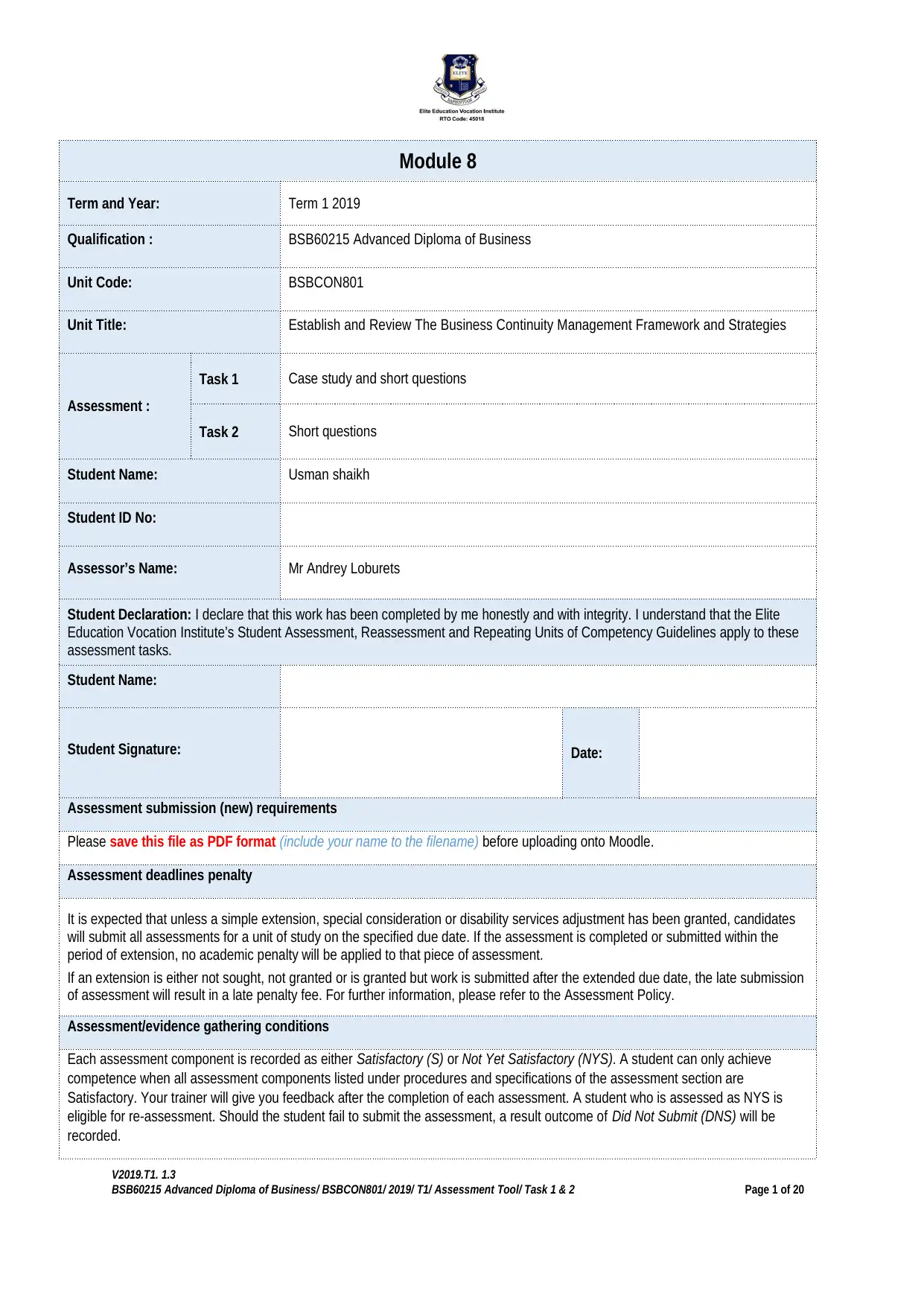
Module 8
Term and Year: Term 1 2019
Qualification : BSB60215 Advanced Diploma of Business
Unit Code: BSBCON801
Unit Title: Establish and Review The Business Continuity Management Framework and Strategies
Assessment :
Task 1 Case study and short questions
Task 2 Short questions
Student Name: Usman shaikh
Student ID No:
Assessor’s Name: Mr Andrey Loburets
Student Declaration: I declare that this work has been completed by me honestly and with integrity. I understand that the Elite
Education Vocation Institute’s Student Assessment, Reassessment and Repeating Units of Competency Guidelines apply to these
assessment tasks.
Student Name:
Student Signature: Date:
Assessment submission (new) requirements
Please save this file as PDF format (include your name to the filename) before uploading onto Moodle.
Assessment deadlines penalty
It is expected that unless a simple extension, special consideration or disability services adjustment has been granted, candidates
will submit all assessments for a unit of study on the specified due date. If the assessment is completed or submitted within the
period of extension, no academic penalty will be applied to that piece of assessment.
If an extension is either not sought, not granted or is granted but work is submitted after the extended due date, the late submission
of assessment will result in a late penalty fee. For further information, please refer to the Assessment Policy.
Assessment/evidence gathering conditions
Each assessment component is recorded as either Satisfactory (S) or Not Yet Satisfactory (NYS). A student can only achieve
competence when all assessment components listed under procedures and specifications of the assessment section are
Satisfactory. Your trainer will give you feedback after the completion of each assessment. A student who is assessed as NYS is
eligible for re-assessment. Should the student fail to submit the assessment, a result outcome of Did Not Submit (DNS) will be
recorded.
V2019.T1. 1.3
BSB60215 Advanced Diploma of Business/ BSBCON801/ 2019/ T1/ Assessment Tool/ Task 1 & 2 Page 1 of 20
Term and Year: Term 1 2019
Qualification : BSB60215 Advanced Diploma of Business
Unit Code: BSBCON801
Unit Title: Establish and Review The Business Continuity Management Framework and Strategies
Assessment :
Task 1 Case study and short questions
Task 2 Short questions
Student Name: Usman shaikh
Student ID No:
Assessor’s Name: Mr Andrey Loburets
Student Declaration: I declare that this work has been completed by me honestly and with integrity. I understand that the Elite
Education Vocation Institute’s Student Assessment, Reassessment and Repeating Units of Competency Guidelines apply to these
assessment tasks.
Student Name:
Student Signature: Date:
Assessment submission (new) requirements
Please save this file as PDF format (include your name to the filename) before uploading onto Moodle.
Assessment deadlines penalty
It is expected that unless a simple extension, special consideration or disability services adjustment has been granted, candidates
will submit all assessments for a unit of study on the specified due date. If the assessment is completed or submitted within the
period of extension, no academic penalty will be applied to that piece of assessment.
If an extension is either not sought, not granted or is granted but work is submitted after the extended due date, the late submission
of assessment will result in a late penalty fee. For further information, please refer to the Assessment Policy.
Assessment/evidence gathering conditions
Each assessment component is recorded as either Satisfactory (S) or Not Yet Satisfactory (NYS). A student can only achieve
competence when all assessment components listed under procedures and specifications of the assessment section are
Satisfactory. Your trainer will give you feedback after the completion of each assessment. A student who is assessed as NYS is
eligible for re-assessment. Should the student fail to submit the assessment, a result outcome of Did Not Submit (DNS) will be
recorded.
V2019.T1. 1.3
BSB60215 Advanced Diploma of Business/ BSBCON801/ 2019/ T1/ Assessment Tool/ Task 1 & 2 Page 1 of 20
Paraphrase This Document
Need a fresh take? Get an instant paraphrase of this document with our AI Paraphraser
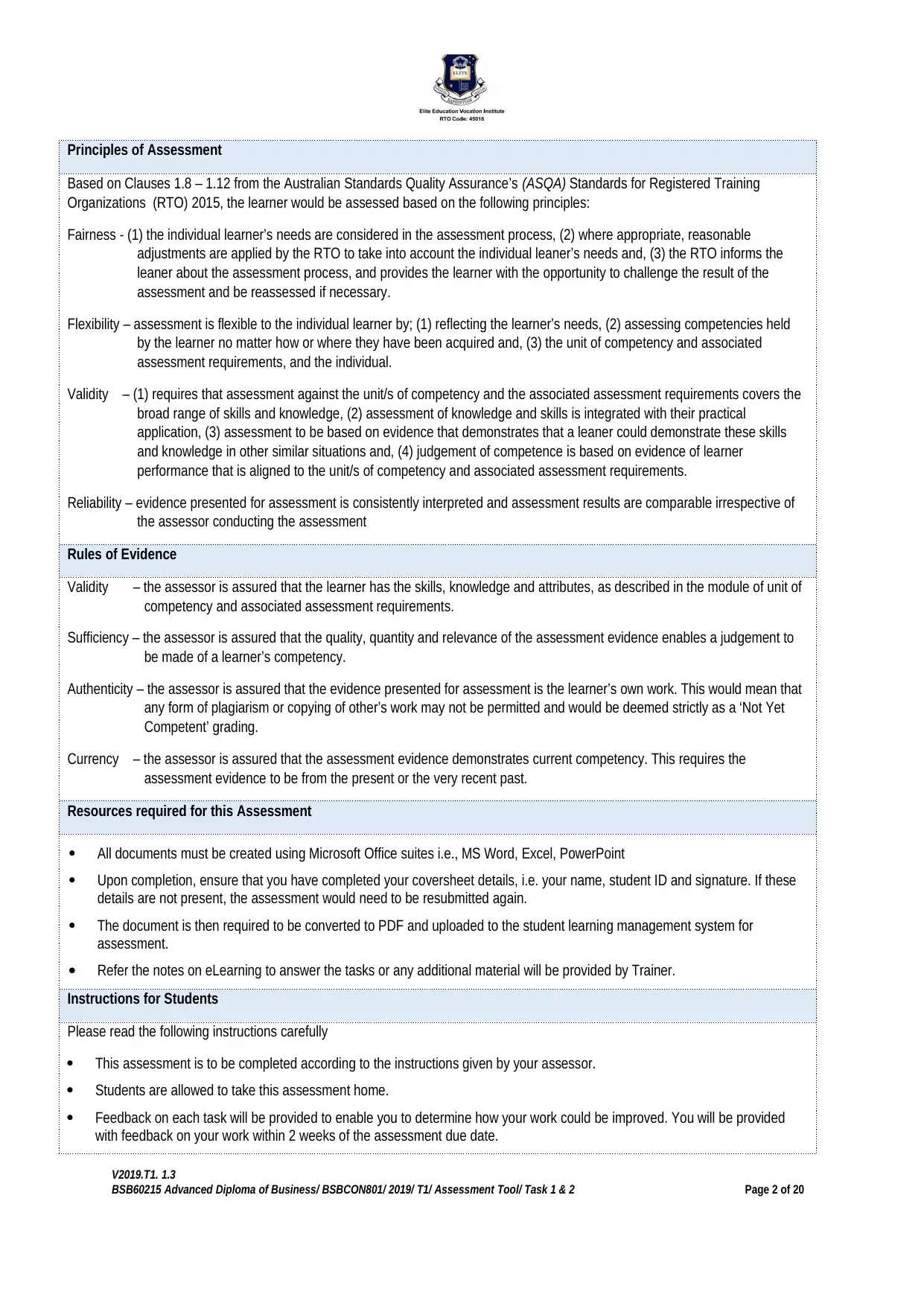
Principles of Assessment
Based on Clauses 1.8 – 1.12 from the Australian Standards Quality Assurance’s (ASQA) Standards for Registered Training
Organizations (RTO) 2015, the learner would be assessed based on the following principles:
Fairness - (1) the individual learner’s needs are considered in the assessment process, (2) where appropriate, reasonable
adjustments are applied by the RTO to take into account the individual leaner’s needs and, (3) the RTO informs the
leaner about the assessment process, and provides the learner with the opportunity to challenge the result of the
assessment and be reassessed if necessary.
Flexibility – assessment is flexible to the individual learner by; (1) reflecting the learner’s needs, (2) assessing competencies held
by the learner no matter how or where they have been acquired and, (3) the unit of competency and associated
assessment requirements, and the individual.
Validity – (1) requires that assessment against the unit/s of competency and the associated assessment requirements covers the
broad range of skills and knowledge, (2) assessment of knowledge and skills is integrated with their practical
application, (3) assessment to be based on evidence that demonstrates that a leaner could demonstrate these skills
and knowledge in other similar situations and, (4) judgement of competence is based on evidence of learner
performance that is aligned to the unit/s of competency and associated assessment requirements.
Reliability – evidence presented for assessment is consistently interpreted and assessment results are comparable irrespective of
the assessor conducting the assessment
Rules of Evidence
Validity – the assessor is assured that the learner has the skills, knowledge and attributes, as described in the module of unit of
competency and associated assessment requirements.
Sufficiency – the assessor is assured that the quality, quantity and relevance of the assessment evidence enables a judgement to
be made of a learner’s competency.
Authenticity – the assessor is assured that the evidence presented for assessment is the learner’s own work. This would mean that
any form of plagiarism or copying of other’s work may not be permitted and would be deemed strictly as a ‘Not Yet
Competent’ grading.
Currency – the assessor is assured that the assessment evidence demonstrates current competency. This requires the
assessment evidence to be from the present or the very recent past.
Resources required for this Assessment
All documents must be created using Microsoft Office suites i.e., MS Word, Excel, PowerPoint
Upon completion, ensure that you have completed your coversheet details, i.e. your name, student ID and signature. If these
details are not present, the assessment would need to be resubmitted again.
The document is then required to be converted to PDF and uploaded to the student learning management system for
assessment.
Refer the notes on eLearning to answer the tasks or any additional material will be provided by Trainer.
Instructions for Students
Please read the following instructions carefully
This assessment is to be completed according to the instructions given by your assessor.
Students are allowed to take this assessment home.
Feedback on each task will be provided to enable you to determine how your work could be improved. You will be provided
with feedback on your work within 2 weeks of the assessment due date.
V2019.T1. 1.3
BSB60215 Advanced Diploma of Business/ BSBCON801/ 2019/ T1/ Assessment Tool/ Task 1 & 2 Page 2 of 20
Based on Clauses 1.8 – 1.12 from the Australian Standards Quality Assurance’s (ASQA) Standards for Registered Training
Organizations (RTO) 2015, the learner would be assessed based on the following principles:
Fairness - (1) the individual learner’s needs are considered in the assessment process, (2) where appropriate, reasonable
adjustments are applied by the RTO to take into account the individual leaner’s needs and, (3) the RTO informs the
leaner about the assessment process, and provides the learner with the opportunity to challenge the result of the
assessment and be reassessed if necessary.
Flexibility – assessment is flexible to the individual learner by; (1) reflecting the learner’s needs, (2) assessing competencies held
by the learner no matter how or where they have been acquired and, (3) the unit of competency and associated
assessment requirements, and the individual.
Validity – (1) requires that assessment against the unit/s of competency and the associated assessment requirements covers the
broad range of skills and knowledge, (2) assessment of knowledge and skills is integrated with their practical
application, (3) assessment to be based on evidence that demonstrates that a leaner could demonstrate these skills
and knowledge in other similar situations and, (4) judgement of competence is based on evidence of learner
performance that is aligned to the unit/s of competency and associated assessment requirements.
Reliability – evidence presented for assessment is consistently interpreted and assessment results are comparable irrespective of
the assessor conducting the assessment
Rules of Evidence
Validity – the assessor is assured that the learner has the skills, knowledge and attributes, as described in the module of unit of
competency and associated assessment requirements.
Sufficiency – the assessor is assured that the quality, quantity and relevance of the assessment evidence enables a judgement to
be made of a learner’s competency.
Authenticity – the assessor is assured that the evidence presented for assessment is the learner’s own work. This would mean that
any form of plagiarism or copying of other’s work may not be permitted and would be deemed strictly as a ‘Not Yet
Competent’ grading.
Currency – the assessor is assured that the assessment evidence demonstrates current competency. This requires the
assessment evidence to be from the present or the very recent past.
Resources required for this Assessment
All documents must be created using Microsoft Office suites i.e., MS Word, Excel, PowerPoint
Upon completion, ensure that you have completed your coversheet details, i.e. your name, student ID and signature. If these
details are not present, the assessment would need to be resubmitted again.
The document is then required to be converted to PDF and uploaded to the student learning management system for
assessment.
Refer the notes on eLearning to answer the tasks or any additional material will be provided by Trainer.
Instructions for Students
Please read the following instructions carefully
This assessment is to be completed according to the instructions given by your assessor.
Students are allowed to take this assessment home.
Feedback on each task will be provided to enable you to determine how your work could be improved. You will be provided
with feedback on your work within 2 weeks of the assessment due date.
V2019.T1. 1.3
BSB60215 Advanced Diploma of Business/ BSBCON801/ 2019/ T1/ Assessment Tool/ Task 1 & 2 Page 2 of 20
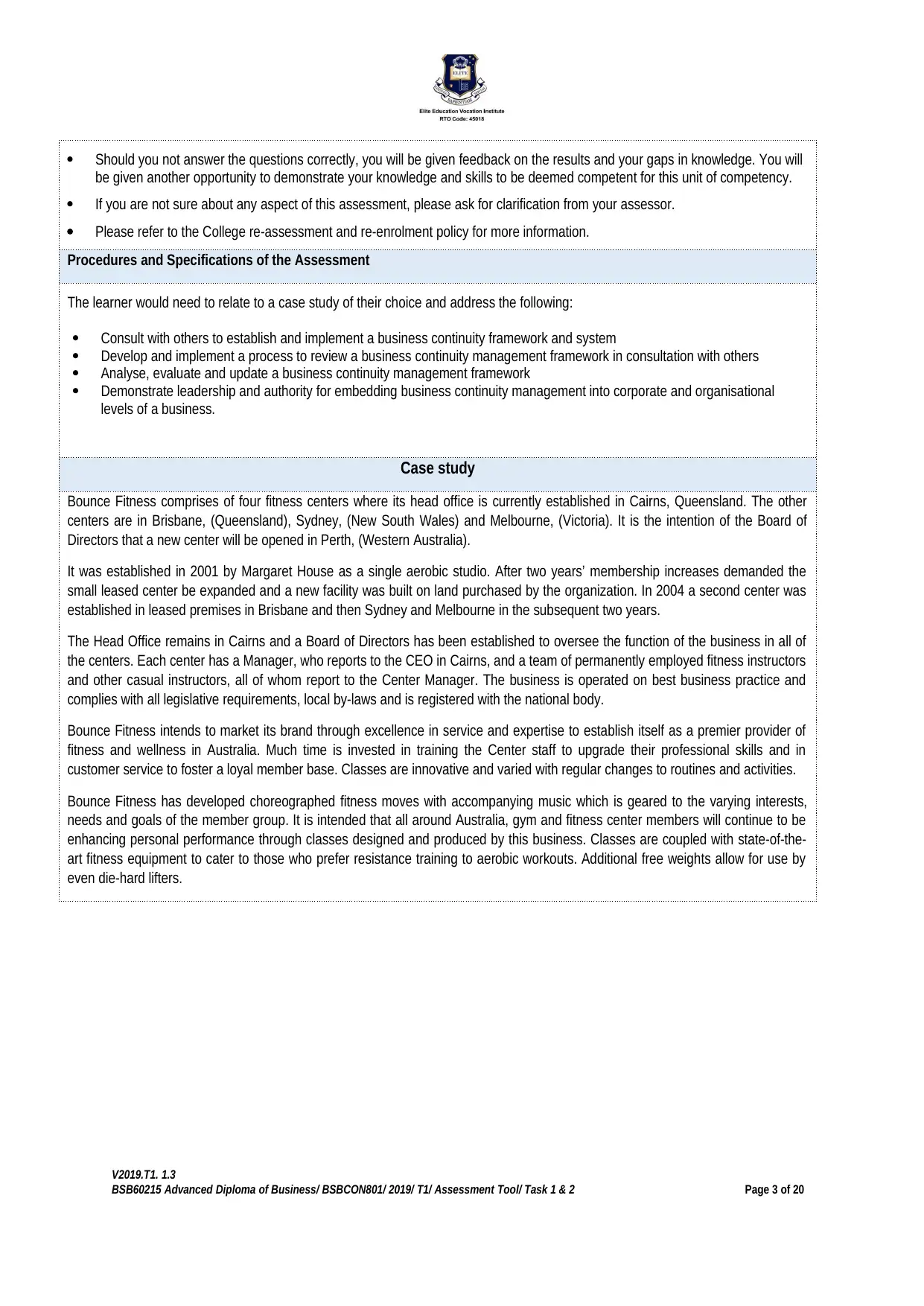
Should you not answer the questions correctly, you will be given feedback on the results and your gaps in knowledge. You will
be given another opportunity to demonstrate your knowledge and skills to be deemed competent for this unit of competency.
If you are not sure about any aspect of this assessment, please ask for clarification from your assessor.
Please refer to the College re-assessment and re-enrolment policy for more information.
Procedures and Specifications of the Assessment
The learner would need to relate to a case study of their choice and address the following:
Consult with others to establish and implement a business continuity framework and system
Develop and implement a process to review a business continuity management framework in consultation with others
Analyse, evaluate and update a business continuity management framework
Demonstrate leadership and authority for embedding business continuity management into corporate and organisational
levels of a business.
Case study
Bounce Fitness comprises of four fitness centers where its head office is currently established in Cairns, Queensland. The other
centers are in Brisbane, (Queensland), Sydney, (New South Wales) and Melbourne, (Victoria). It is the intention of the Board of
Directors that a new center will be opened in Perth, (Western Australia).
It was established in 2001 by Margaret House as a single aerobic studio. After two years’ membership increases demanded the
small leased center be expanded and a new facility was built on land purchased by the organization. In 2004 a second center was
established in leased premises in Brisbane and then Sydney and Melbourne in the subsequent two years.
The Head Office remains in Cairns and a Board of Directors has been established to oversee the function of the business in all of
the centers. Each center has a Manager, who reports to the CEO in Cairns, and a team of permanently employed fitness instructors
and other casual instructors, all of whom report to the Center Manager. The business is operated on best business practice and
complies with all legislative requirements, local by-laws and is registered with the national body.
Bounce Fitness intends to market its brand through excellence in service and expertise to establish itself as a premier provider of
fitness and wellness in Australia. Much time is invested in training the Center staff to upgrade their professional skills and in
customer service to foster a loyal member base. Classes are innovative and varied with regular changes to routines and activities.
Bounce Fitness has developed choreographed fitness moves with accompanying music which is geared to the varying interests,
needs and goals of the member group. It is intended that all around Australia, gym and fitness center members will continue to be
enhancing personal performance through classes designed and produced by this business. Classes are coupled with state-of-the-
art fitness equipment to cater to those who prefer resistance training to aerobic workouts. Additional free weights allow for use by
even die-hard lifters.
V2019.T1. 1.3
BSB60215 Advanced Diploma of Business/ BSBCON801/ 2019/ T1/ Assessment Tool/ Task 1 & 2 Page 3 of 20
be given another opportunity to demonstrate your knowledge and skills to be deemed competent for this unit of competency.
If you are not sure about any aspect of this assessment, please ask for clarification from your assessor.
Please refer to the College re-assessment and re-enrolment policy for more information.
Procedures and Specifications of the Assessment
The learner would need to relate to a case study of their choice and address the following:
Consult with others to establish and implement a business continuity framework and system
Develop and implement a process to review a business continuity management framework in consultation with others
Analyse, evaluate and update a business continuity management framework
Demonstrate leadership and authority for embedding business continuity management into corporate and organisational
levels of a business.
Case study
Bounce Fitness comprises of four fitness centers where its head office is currently established in Cairns, Queensland. The other
centers are in Brisbane, (Queensland), Sydney, (New South Wales) and Melbourne, (Victoria). It is the intention of the Board of
Directors that a new center will be opened in Perth, (Western Australia).
It was established in 2001 by Margaret House as a single aerobic studio. After two years’ membership increases demanded the
small leased center be expanded and a new facility was built on land purchased by the organization. In 2004 a second center was
established in leased premises in Brisbane and then Sydney and Melbourne in the subsequent two years.
The Head Office remains in Cairns and a Board of Directors has been established to oversee the function of the business in all of
the centers. Each center has a Manager, who reports to the CEO in Cairns, and a team of permanently employed fitness instructors
and other casual instructors, all of whom report to the Center Manager. The business is operated on best business practice and
complies with all legislative requirements, local by-laws and is registered with the national body.
Bounce Fitness intends to market its brand through excellence in service and expertise to establish itself as a premier provider of
fitness and wellness in Australia. Much time is invested in training the Center staff to upgrade their professional skills and in
customer service to foster a loyal member base. Classes are innovative and varied with regular changes to routines and activities.
Bounce Fitness has developed choreographed fitness moves with accompanying music which is geared to the varying interests,
needs and goals of the member group. It is intended that all around Australia, gym and fitness center members will continue to be
enhancing personal performance through classes designed and produced by this business. Classes are coupled with state-of-the-
art fitness equipment to cater to those who prefer resistance training to aerobic workouts. Additional free weights allow for use by
even die-hard lifters.
V2019.T1. 1.3
BSB60215 Advanced Diploma of Business/ BSBCON801/ 2019/ T1/ Assessment Tool/ Task 1 & 2 Page 3 of 20
⊘ This is a preview!⊘
Do you want full access?
Subscribe today to unlock all pages.

Trusted by 1+ million students worldwide
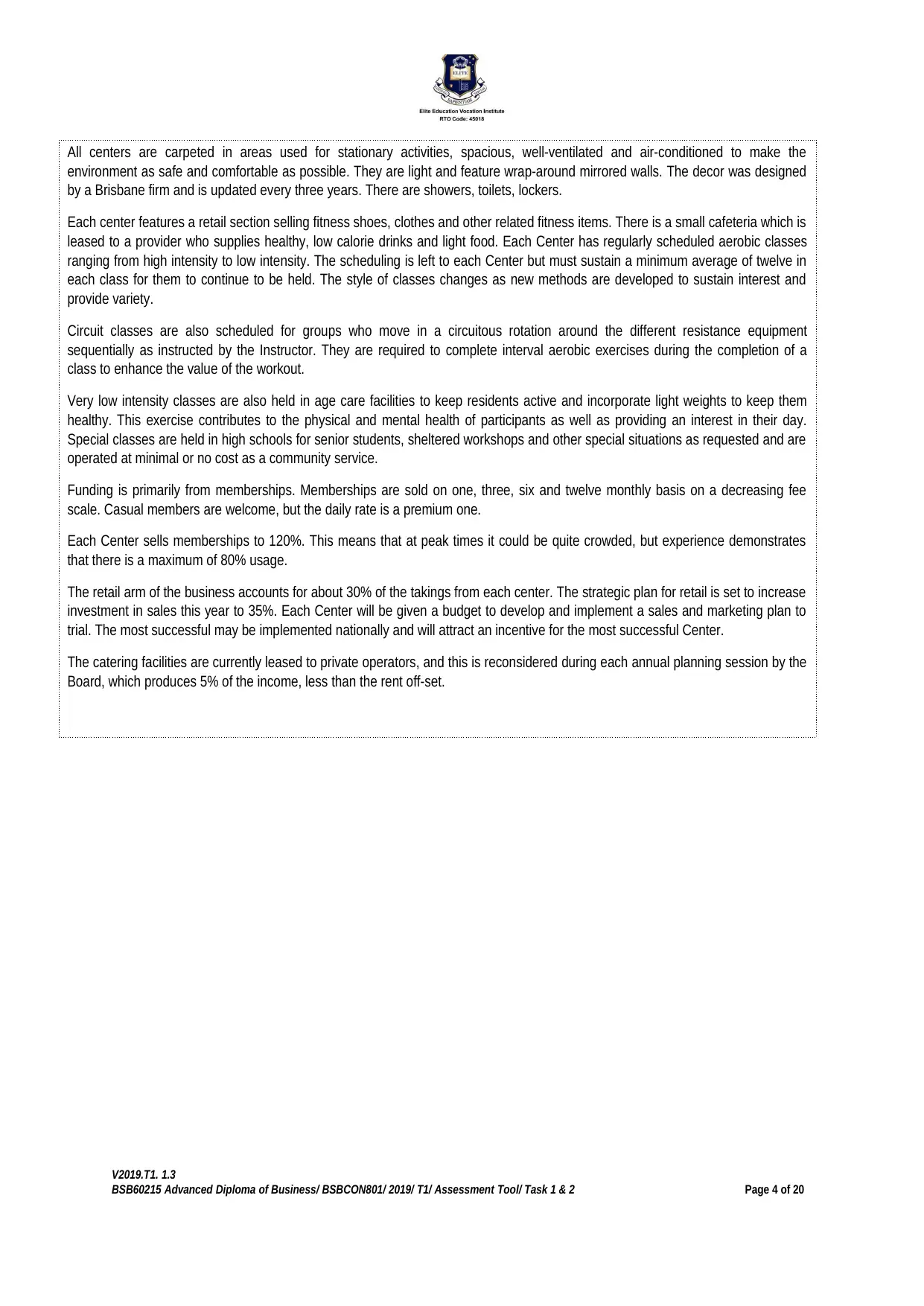
All centers are carpeted in areas used for stationary activities, spacious, well-ventilated and air-conditioned to make the
environment as safe and comfortable as possible. They are light and feature wrap-around mirrored walls. The decor was designed
by a Brisbane firm and is updated every three years. There are showers, toilets, lockers.
Each center features a retail section selling fitness shoes, clothes and other related fitness items. There is a small cafeteria which is
leased to a provider who supplies healthy, low calorie drinks and light food. Each Center has regularly scheduled aerobic classes
ranging from high intensity to low intensity. The scheduling is left to each Center but must sustain a minimum average of twelve in
each class for them to continue to be held. The style of classes changes as new methods are developed to sustain interest and
provide variety.
Circuit classes are also scheduled for groups who move in a circuitous rotation around the different resistance equipment
sequentially as instructed by the Instructor. They are required to complete interval aerobic exercises during the completion of a
class to enhance the value of the workout.
Very low intensity classes are also held in age care facilities to keep residents active and incorporate light weights to keep them
healthy. This exercise contributes to the physical and mental health of participants as well as providing an interest in their day.
Special classes are held in high schools for senior students, sheltered workshops and other special situations as requested and are
operated at minimal or no cost as a community service.
Funding is primarily from memberships. Memberships are sold on one, three, six and twelve monthly basis on a decreasing fee
scale. Casual members are welcome, but the daily rate is a premium one.
Each Center sells memberships to 120%. This means that at peak times it could be quite crowded, but experience demonstrates
that there is a maximum of 80% usage.
The retail arm of the business accounts for about 30% of the takings from each center. The strategic plan for retail is set to increase
investment in sales this year to 35%. Each Center will be given a budget to develop and implement a sales and marketing plan to
trial. The most successful may be implemented nationally and will attract an incentive for the most successful Center.
The catering facilities are currently leased to private operators, and this is reconsidered during each annual planning session by the
Board, which produces 5% of the income, less than the rent off-set.
V2019.T1. 1.3
BSB60215 Advanced Diploma of Business/ BSBCON801/ 2019/ T1/ Assessment Tool/ Task 1 & 2 Page 4 of 20
environment as safe and comfortable as possible. They are light and feature wrap-around mirrored walls. The decor was designed
by a Brisbane firm and is updated every three years. There are showers, toilets, lockers.
Each center features a retail section selling fitness shoes, clothes and other related fitness items. There is a small cafeteria which is
leased to a provider who supplies healthy, low calorie drinks and light food. Each Center has regularly scheduled aerobic classes
ranging from high intensity to low intensity. The scheduling is left to each Center but must sustain a minimum average of twelve in
each class for them to continue to be held. The style of classes changes as new methods are developed to sustain interest and
provide variety.
Circuit classes are also scheduled for groups who move in a circuitous rotation around the different resistance equipment
sequentially as instructed by the Instructor. They are required to complete interval aerobic exercises during the completion of a
class to enhance the value of the workout.
Very low intensity classes are also held in age care facilities to keep residents active and incorporate light weights to keep them
healthy. This exercise contributes to the physical and mental health of participants as well as providing an interest in their day.
Special classes are held in high schools for senior students, sheltered workshops and other special situations as requested and are
operated at minimal or no cost as a community service.
Funding is primarily from memberships. Memberships are sold on one, three, six and twelve monthly basis on a decreasing fee
scale. Casual members are welcome, but the daily rate is a premium one.
Each Center sells memberships to 120%. This means that at peak times it could be quite crowded, but experience demonstrates
that there is a maximum of 80% usage.
The retail arm of the business accounts for about 30% of the takings from each center. The strategic plan for retail is set to increase
investment in sales this year to 35%. Each Center will be given a budget to develop and implement a sales and marketing plan to
trial. The most successful may be implemented nationally and will attract an incentive for the most successful Center.
The catering facilities are currently leased to private operators, and this is reconsidered during each annual planning session by the
Board, which produces 5% of the income, less than the rent off-set.
V2019.T1. 1.3
BSB60215 Advanced Diploma of Business/ BSBCON801/ 2019/ T1/ Assessment Tool/ Task 1 & 2 Page 4 of 20
Paraphrase This Document
Need a fresh take? Get an instant paraphrase of this document with our AI Paraphraser
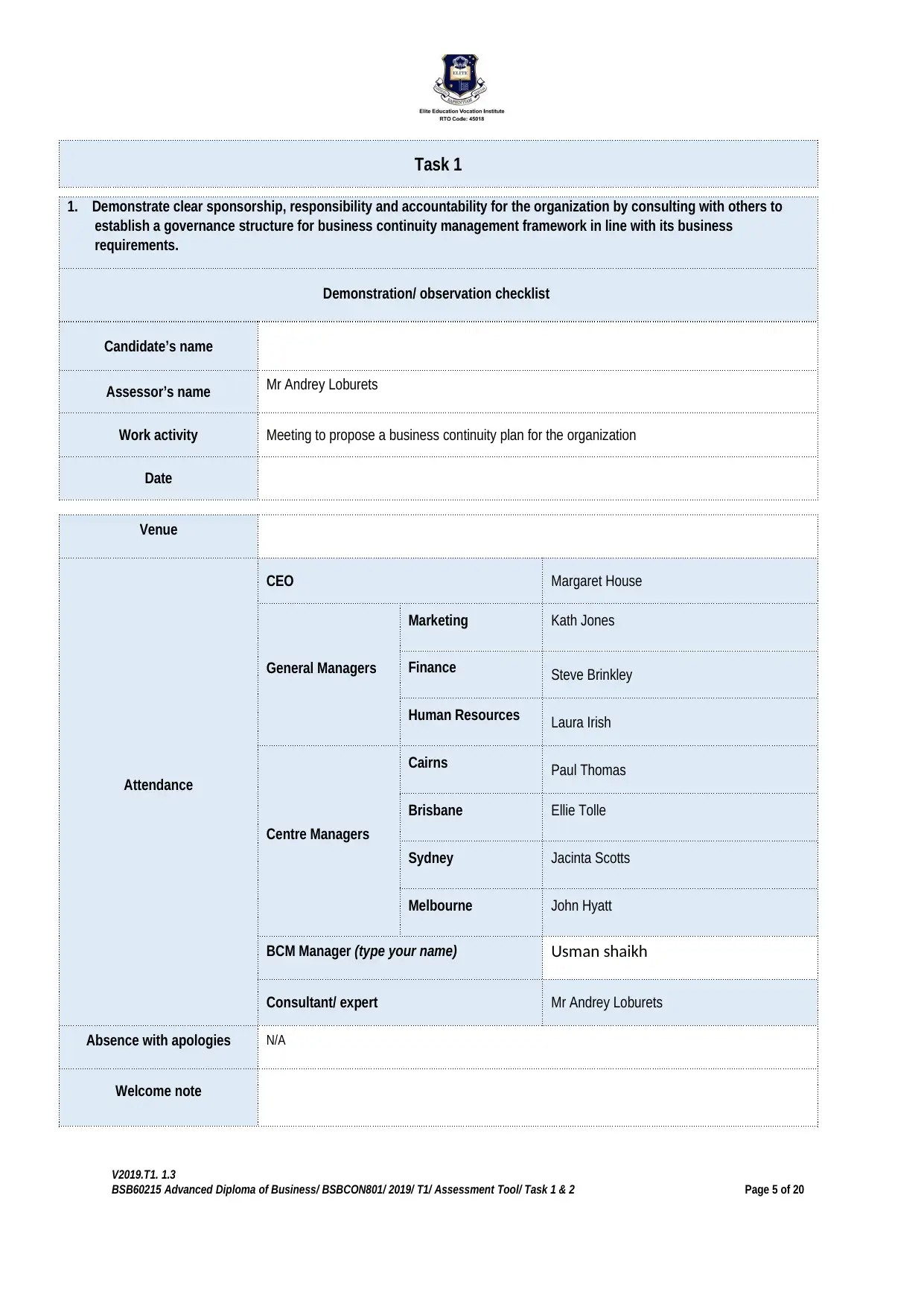
Task 1
1. Demonstrate clear sponsorship, responsibility and accountability for the organization by consulting with others to
establish a governance structure for business continuity management framework in line with its business
requirements.
Demonstration/ observation checklist
Candidate’s name
Assessor’s name Mr Andrey Loburets
Work activity Meeting to propose a business continuity plan for the organization
Date
Venue
Attendance
CEO Margaret House
General Managers
Marketing Kath Jones
Finance Steve Brinkley
Human Resources Laura Irish
Centre Managers
Cairns Paul Thomas
Brisbane Ellie Tolle
Sydney Jacinta Scotts
Melbourne John Hyatt
BCM Manager (type your name) Usman shaikh
Consultant/ expert Mr Andrey Loburets
Absence with apologies N/A
Welcome note
V2019.T1. 1.3
BSB60215 Advanced Diploma of Business/ BSBCON801/ 2019/ T1/ Assessment Tool/ Task 1 & 2 Page 5 of 20
1. Demonstrate clear sponsorship, responsibility and accountability for the organization by consulting with others to
establish a governance structure for business continuity management framework in line with its business
requirements.
Demonstration/ observation checklist
Candidate’s name
Assessor’s name Mr Andrey Loburets
Work activity Meeting to propose a business continuity plan for the organization
Date
Venue
Attendance
CEO Margaret House
General Managers
Marketing Kath Jones
Finance Steve Brinkley
Human Resources Laura Irish
Centre Managers
Cairns Paul Thomas
Brisbane Ellie Tolle
Sydney Jacinta Scotts
Melbourne John Hyatt
BCM Manager (type your name) Usman shaikh
Consultant/ expert Mr Andrey Loburets
Absence with apologies N/A
Welcome note
V2019.T1. 1.3
BSB60215 Advanced Diploma of Business/ BSBCON801/ 2019/ T1/ Assessment Tool/ Task 1 & 2 Page 5 of 20
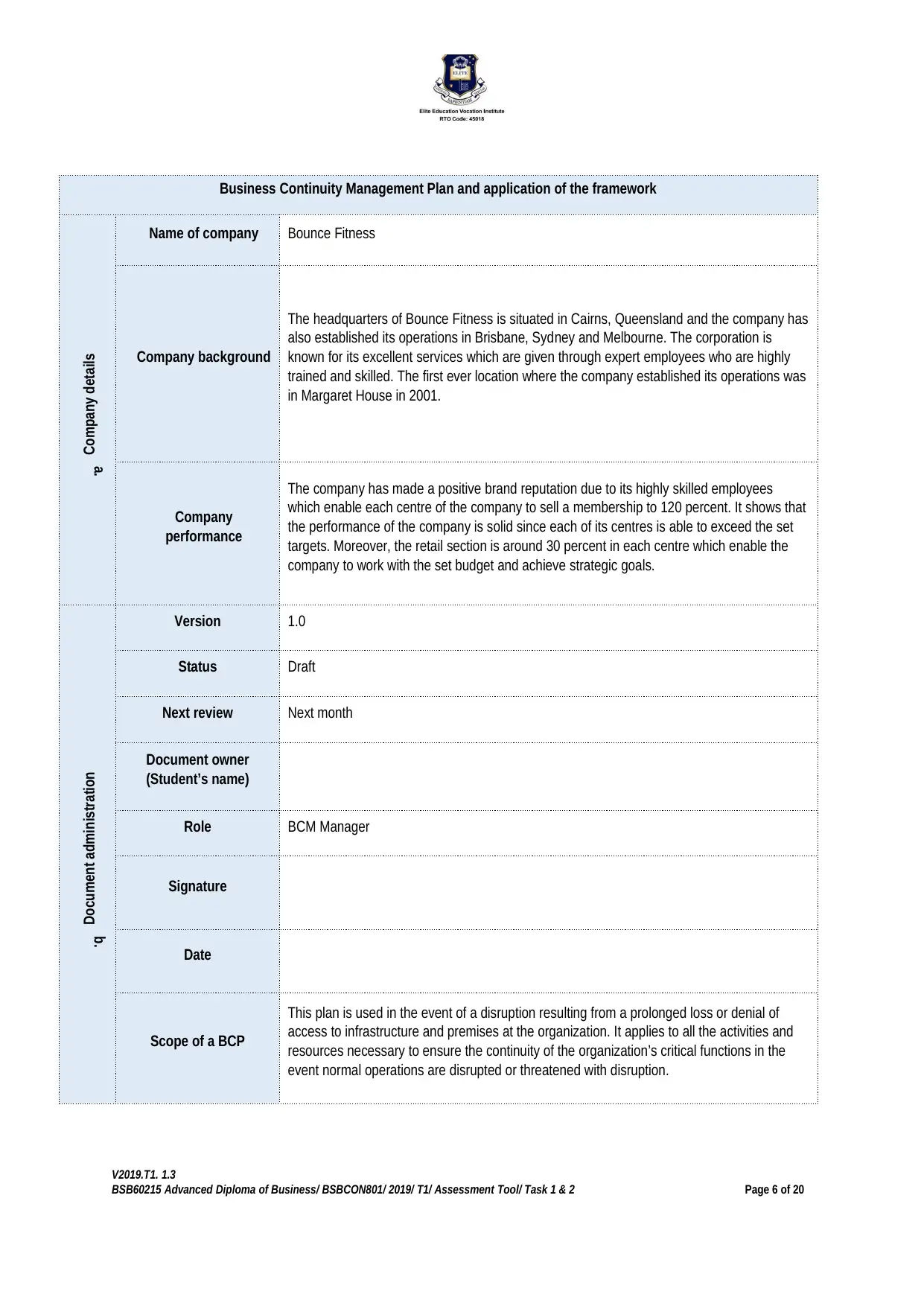
Business Continuity Management Plan and application of the framework
a. Company details
Name of company Bounce Fitness
Company background
The headquarters of Bounce Fitness is situated in Cairns, Queensland and the company has
also established its operations in Brisbane, Sydney and Melbourne. The corporation is
known for its excellent services which are given through expert employees who are highly
trained and skilled. The first ever location where the company established its operations was
in Margaret House in 2001.
Company
performance
The company has made a positive brand reputation due to its highly skilled employees
which enable each centre of the company to sell a membership to 120 percent. It shows that
the performance of the company is solid since each of its centres is able to exceed the set
targets. Moreover, the retail section is around 30 percent in each centre which enable the
company to work with the set budget and achieve strategic goals.
b. Document administration
Version 1.0
Status Draft
Next review Next month
Document owner
(Student’s name)
Role BCM Manager
Signature
Date
Scope of a BCP
This plan is used in the event of a disruption resulting from a prolonged loss or denial of
access to infrastructure and premises at the organization. It applies to all the activities and
resources necessary to ensure the continuity of the organization’s critical functions in the
event normal operations are disrupted or threatened with disruption.
V2019.T1. 1.3
BSB60215 Advanced Diploma of Business/ BSBCON801/ 2019/ T1/ Assessment Tool/ Task 1 & 2 Page 6 of 20
a. Company details
Name of company Bounce Fitness
Company background
The headquarters of Bounce Fitness is situated in Cairns, Queensland and the company has
also established its operations in Brisbane, Sydney and Melbourne. The corporation is
known for its excellent services which are given through expert employees who are highly
trained and skilled. The first ever location where the company established its operations was
in Margaret House in 2001.
Company
performance
The company has made a positive brand reputation due to its highly skilled employees
which enable each centre of the company to sell a membership to 120 percent. It shows that
the performance of the company is solid since each of its centres is able to exceed the set
targets. Moreover, the retail section is around 30 percent in each centre which enable the
company to work with the set budget and achieve strategic goals.
b. Document administration
Version 1.0
Status Draft
Next review Next month
Document owner
(Student’s name)
Role BCM Manager
Signature
Date
Scope of a BCP
This plan is used in the event of a disruption resulting from a prolonged loss or denial of
access to infrastructure and premises at the organization. It applies to all the activities and
resources necessary to ensure the continuity of the organization’s critical functions in the
event normal operations are disrupted or threatened with disruption.
V2019.T1. 1.3
BSB60215 Advanced Diploma of Business/ BSBCON801/ 2019/ T1/ Assessment Tool/ Task 1 & 2 Page 6 of 20
⊘ This is a preview!⊘
Do you want full access?
Subscribe today to unlock all pages.

Trusted by 1+ million students worldwide
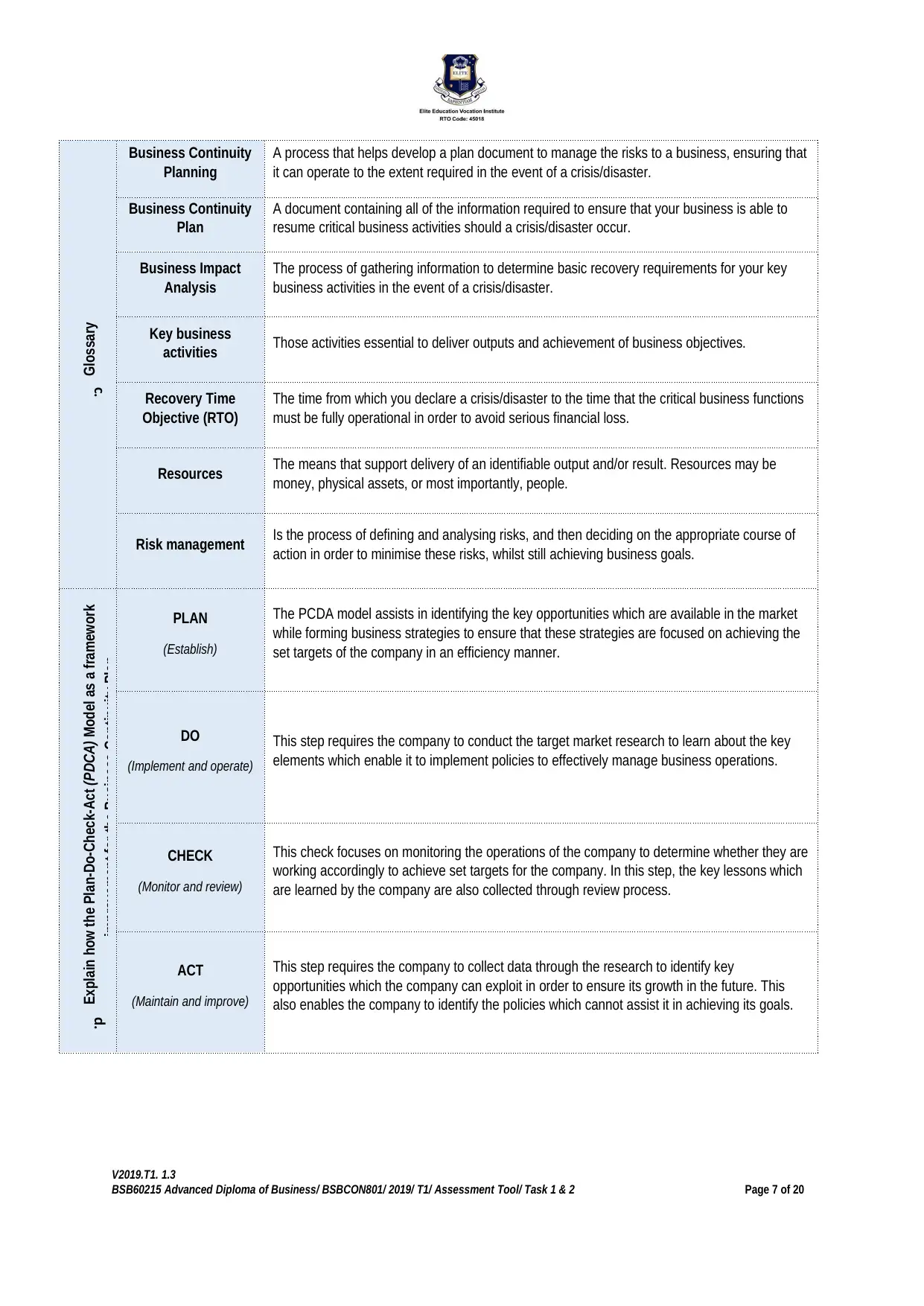
c. Glossary
Business Continuity
Planning
A process that helps develop a plan document to manage the risks to a business, ensuring that
it can operate to the extent required in the event of a crisis/disaster.
Business Continuity
Plan
A document containing all of the information required to ensure that your business is able to
resume critical business activities should a crisis/disaster occur.
Business Impact
Analysis
The process of gathering information to determine basic recovery requirements for your key
business activities in the event of a crisis/disaster.
Key business
activities Those activities essential to deliver outputs and achievement of business objectives.
Recovery Time
Objective (RTO)
The time from which you declare a crisis/disaster to the time that the critical business functions
must be fully operational in order to avoid serious financial loss.
Resources The means that support delivery of an identifiable output and/or result. Resources may be
money, physical assets, or most importantly, people.
Risk management Is the process of defining and analysing risks, and then deciding on the appropriate course of
action in order to minimise these risks, whilst still achieving business goals.
d. Explain how the Plan-Do-Check-Act (PDCA) Model as a framework
improvement for the Business Continuity Plan
PLAN
(Establish)
The PCDA model assists in identifying the key opportunities which are available in the market
while forming business strategies to ensure that these strategies are focused on achieving the
set targets of the company in an efficiency manner.
DO
(Implement and operate)
This step requires the company to conduct the target market research to learn about the key
elements which enable it to implement policies to effectively manage business operations.
CHECK
(Monitor and review)
This check focuses on monitoring the operations of the company to determine whether they are
working accordingly to achieve set targets for the company. In this step, the key lessons which
are learned by the company are also collected through review process.
ACT
(Maintain and improve)
This step requires the company to collect data through the research to identify key
opportunities which the company can exploit in order to ensure its growth in the future. This
also enables the company to identify the policies which cannot assist it in achieving its goals.
V2019.T1. 1.3
BSB60215 Advanced Diploma of Business/ BSBCON801/ 2019/ T1/ Assessment Tool/ Task 1 & 2 Page 7 of 20
Business Continuity
Planning
A process that helps develop a plan document to manage the risks to a business, ensuring that
it can operate to the extent required in the event of a crisis/disaster.
Business Continuity
Plan
A document containing all of the information required to ensure that your business is able to
resume critical business activities should a crisis/disaster occur.
Business Impact
Analysis
The process of gathering information to determine basic recovery requirements for your key
business activities in the event of a crisis/disaster.
Key business
activities Those activities essential to deliver outputs and achievement of business objectives.
Recovery Time
Objective (RTO)
The time from which you declare a crisis/disaster to the time that the critical business functions
must be fully operational in order to avoid serious financial loss.
Resources The means that support delivery of an identifiable output and/or result. Resources may be
money, physical assets, or most importantly, people.
Risk management Is the process of defining and analysing risks, and then deciding on the appropriate course of
action in order to minimise these risks, whilst still achieving business goals.
d. Explain how the Plan-Do-Check-Act (PDCA) Model as a framework
improvement for the Business Continuity Plan
PLAN
(Establish)
The PCDA model assists in identifying the key opportunities which are available in the market
while forming business strategies to ensure that these strategies are focused on achieving the
set targets of the company in an efficiency manner.
DO
(Implement and operate)
This step requires the company to conduct the target market research to learn about the key
elements which enable it to implement policies to effectively manage business operations.
CHECK
(Monitor and review)
This check focuses on monitoring the operations of the company to determine whether they are
working accordingly to achieve set targets for the company. In this step, the key lessons which
are learned by the company are also collected through review process.
ACT
(Maintain and improve)
This step requires the company to collect data through the research to identify key
opportunities which the company can exploit in order to ensure its growth in the future. This
also enables the company to identify the policies which cannot assist it in achieving its goals.
V2019.T1. 1.3
BSB60215 Advanced Diploma of Business/ BSBCON801/ 2019/ T1/ Assessment Tool/ Task 1 & 2 Page 7 of 20
Paraphrase This Document
Need a fresh take? Get an instant paraphrase of this document with our AI Paraphraser
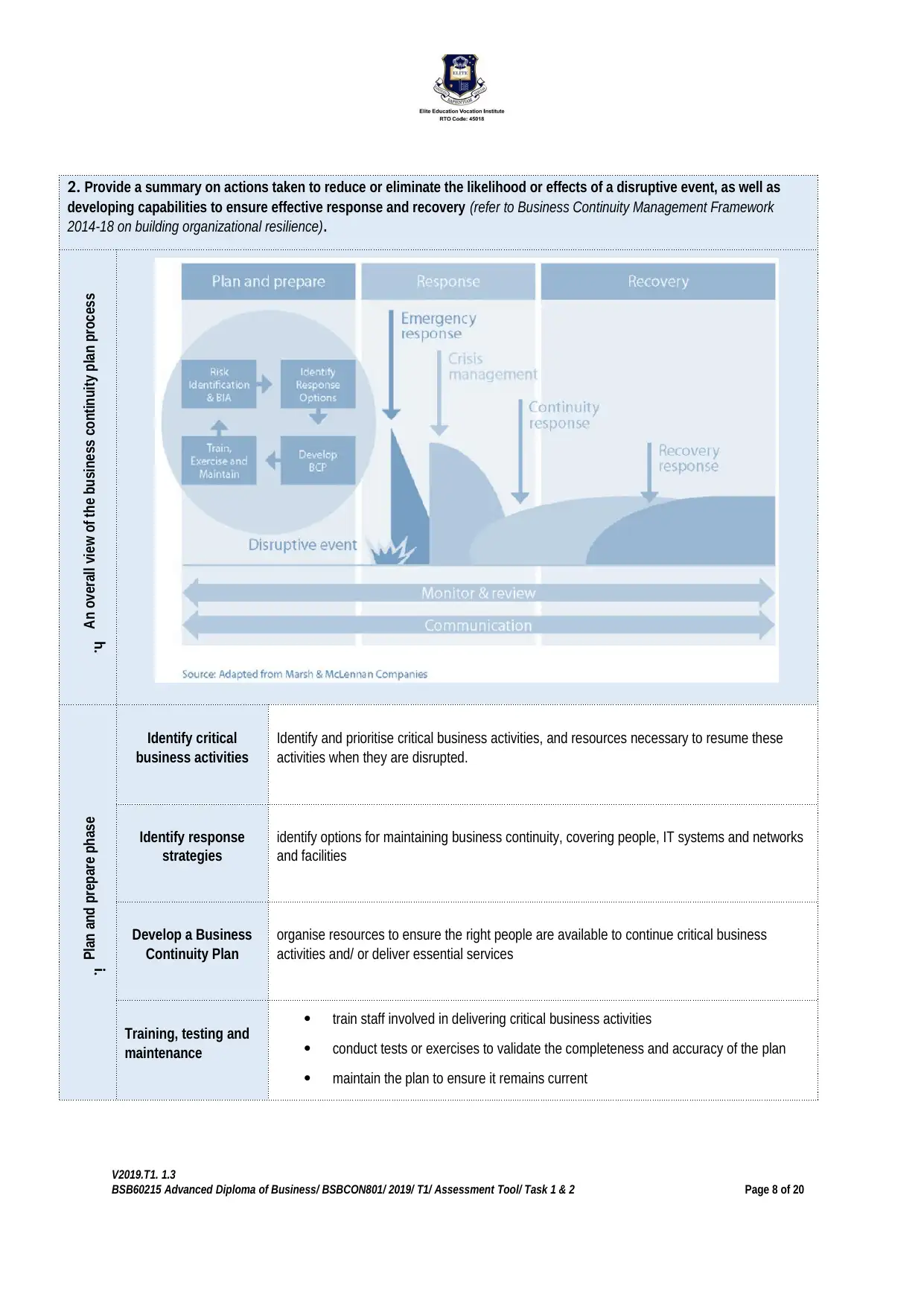
2. Provide a summary on actions taken to reduce or eliminate the likelihood or effects of a disruptive event, as well as
developing capabilities to ensure effective response and recovery (refer to Business Continuity Management Framework
2014-18 on building organizational resilience).
h. An overall view of the business continuity plan process i. Plan and prepare phase
Identify critical
business activities
Identify and prioritise critical business activities, and resources necessary to resume these
activities when they are disrupted.
Identify response
strategies
identify options for maintaining business continuity, covering people, IT systems and networks
and facilities
Develop a Business
Continuity Plan
organise resources to ensure the right people are available to continue critical business
activities and/ or deliver essential services
Training, testing and
maintenance
train staff involved in delivering critical business activities
conduct tests or exercises to validate the completeness and accuracy of the plan
maintain the plan to ensure it remains current
V2019.T1. 1.3
BSB60215 Advanced Diploma of Business/ BSBCON801/ 2019/ T1/ Assessment Tool/ Task 1 & 2 Page 8 of 20
developing capabilities to ensure effective response and recovery (refer to Business Continuity Management Framework
2014-18 on building organizational resilience).
h. An overall view of the business continuity plan process i. Plan and prepare phase
Identify critical
business activities
Identify and prioritise critical business activities, and resources necessary to resume these
activities when they are disrupted.
Identify response
strategies
identify options for maintaining business continuity, covering people, IT systems and networks
and facilities
Develop a Business
Continuity Plan
organise resources to ensure the right people are available to continue critical business
activities and/ or deliver essential services
Training, testing and
maintenance
train staff involved in delivering critical business activities
conduct tests or exercises to validate the completeness and accuracy of the plan
maintain the plan to ensure it remains current
V2019.T1. 1.3
BSB60215 Advanced Diploma of Business/ BSBCON801/ 2019/ T1/ Assessment Tool/ Task 1 & 2 Page 8 of 20
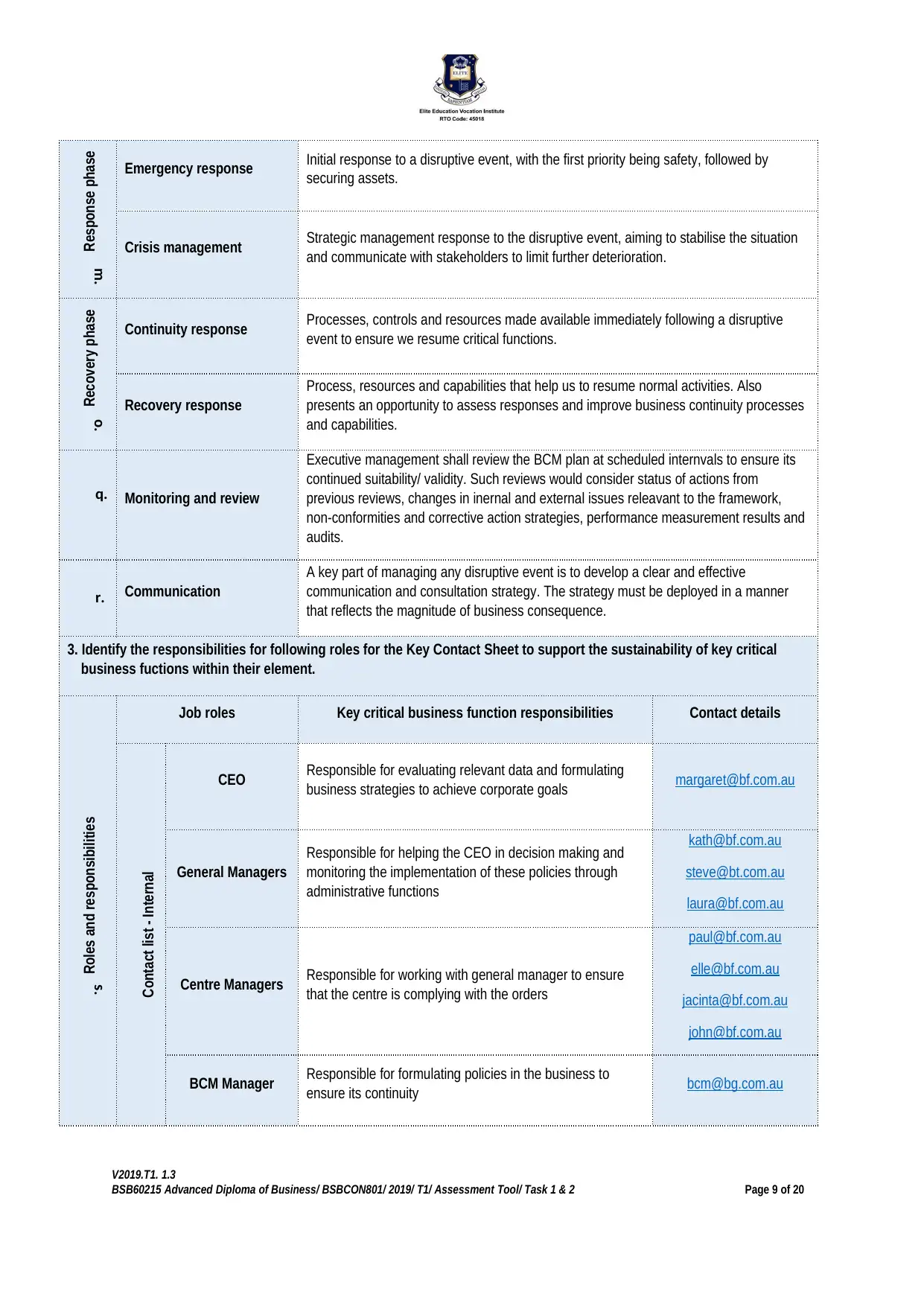
m. Response phase
Emergency response Initial response to a disruptive event, with the first priority being safety, followed by
securing assets.
Crisis management Strategic management response to the disruptive event, aiming to stabilise the situation
and communicate with stakeholders to limit further deterioration.
o. Recovery phase
Continuity response Processes, controls and resources made available immediately following a disruptive
event to ensure we resume critical functions.
Recovery response
Process, resources and capabilities that help us to resume normal activities. Also
presents an opportunity to assess responses and improve business continuity processes
and capabilities.
q. Monitoring and review
Executive management shall review the BCM plan at scheduled internvals to ensure its
continued suitability/ validity. Such reviews would consider status of actions from
previous reviews, changes in inernal and external issues releavant to the framework,
non-conformities and corrective action strategies, performance measurement results and
audits.
r. Communication
A key part of managing any disruptive event is to develop a clear and effective
communication and consultation strategy. The strategy must be deployed in a manner
that reflects the magnitude of business consequence.
3. Identify the responsibilities for following roles for the Key Contact Sheet to support the sustainability of key critical
business fuctions within their element.
s. Roles and responsibilities
Job roles Key critical business function responsibilities Contact details
Contact list - Internal
CEO Responsible for evaluating relevant data and formulating
business strategies to achieve corporate goals margaret@bf.com.au
General Managers
Responsible for helping the CEO in decision making and
monitoring the implementation of these policies through
administrative functions
kath@bf.com.au
steve@bt.com.au
laura@bf.com.au
Centre Managers Responsible for working with general manager to ensure
that the centre is complying with the orders
paul@bf.com.au
elle@bf.com.au
jacinta@bf.com.au
john@bf.com.au
BCM Manager Responsible for formulating policies in the business to
ensure its continuity bcm@bg.com.au
V2019.T1. 1.3
BSB60215 Advanced Diploma of Business/ BSBCON801/ 2019/ T1/ Assessment Tool/ Task 1 & 2 Page 9 of 20
Emergency response Initial response to a disruptive event, with the first priority being safety, followed by
securing assets.
Crisis management Strategic management response to the disruptive event, aiming to stabilise the situation
and communicate with stakeholders to limit further deterioration.
o. Recovery phase
Continuity response Processes, controls and resources made available immediately following a disruptive
event to ensure we resume critical functions.
Recovery response
Process, resources and capabilities that help us to resume normal activities. Also
presents an opportunity to assess responses and improve business continuity processes
and capabilities.
q. Monitoring and review
Executive management shall review the BCM plan at scheduled internvals to ensure its
continued suitability/ validity. Such reviews would consider status of actions from
previous reviews, changes in inernal and external issues releavant to the framework,
non-conformities and corrective action strategies, performance measurement results and
audits.
r. Communication
A key part of managing any disruptive event is to develop a clear and effective
communication and consultation strategy. The strategy must be deployed in a manner
that reflects the magnitude of business consequence.
3. Identify the responsibilities for following roles for the Key Contact Sheet to support the sustainability of key critical
business fuctions within their element.
s. Roles and responsibilities
Job roles Key critical business function responsibilities Contact details
Contact list - Internal
CEO Responsible for evaluating relevant data and formulating
business strategies to achieve corporate goals margaret@bf.com.au
General Managers
Responsible for helping the CEO in decision making and
monitoring the implementation of these policies through
administrative functions
kath@bf.com.au
steve@bt.com.au
laura@bf.com.au
Centre Managers Responsible for working with general manager to ensure
that the centre is complying with the orders
paul@bf.com.au
elle@bf.com.au
jacinta@bf.com.au
john@bf.com.au
BCM Manager Responsible for formulating policies in the business to
ensure its continuity bcm@bg.com.au
V2019.T1. 1.3
BSB60215 Advanced Diploma of Business/ BSBCON801/ 2019/ T1/ Assessment Tool/ Task 1 & 2 Page 9 of 20
⊘ This is a preview!⊘
Do you want full access?
Subscribe today to unlock all pages.

Trusted by 1+ million students worldwide
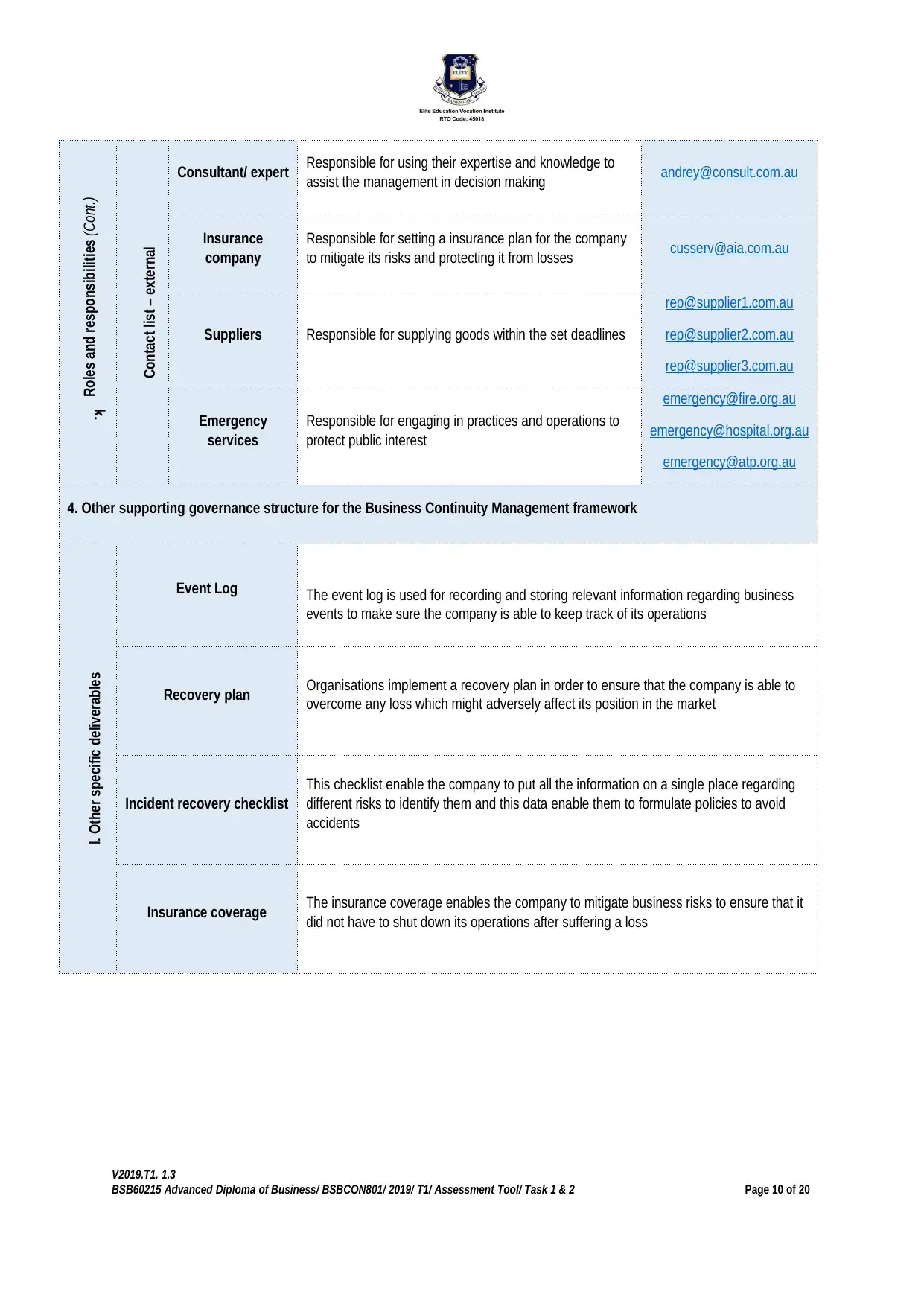
k. Roles and responsibilities (Cont.)
Contact list – external
Consultant/ expert Responsible for using their expertise and knowledge to
assist the management in decision making andrey@consult.com.au
Insurance
company
Responsible for setting a insurance plan for the company
to mitigate its risks and protecting it from losses cusserv@aia.com.au
Suppliers Responsible for supplying goods within the set deadlines
rep@supplier1.com.au
rep@supplier2.com.au
rep@supplier3.com.au
Emergency
services
Responsible for engaging in practices and operations to
protect public interest
emergency@fire.org.au
emergency@hospital.org.au
emergency@atp.org.au
4. Other supporting governance structure for the Business Continuity Management framework
l. Other specific deliverables
Event Log The event log is used for recording and storing relevant information regarding business
events to make sure the company is able to keep track of its operations
Recovery plan Organisations implement a recovery plan in order to ensure that the company is able to
overcome any loss which might adversely affect its position in the market
Incident recovery checklist
This checklist enable the company to put all the information on a single place regarding
different risks to identify them and this data enable them to formulate policies to avoid
accidents
Insurance coverage The insurance coverage enables the company to mitigate business risks to ensure that it
did not have to shut down its operations after suffering a loss
V2019.T1. 1.3
BSB60215 Advanced Diploma of Business/ BSBCON801/ 2019/ T1/ Assessment Tool/ Task 1 & 2 Page 10 of 20
Contact list – external
Consultant/ expert Responsible for using their expertise and knowledge to
assist the management in decision making andrey@consult.com.au
Insurance
company
Responsible for setting a insurance plan for the company
to mitigate its risks and protecting it from losses cusserv@aia.com.au
Suppliers Responsible for supplying goods within the set deadlines
rep@supplier1.com.au
rep@supplier2.com.au
rep@supplier3.com.au
Emergency
services
Responsible for engaging in practices and operations to
protect public interest
emergency@fire.org.au
emergency@hospital.org.au
emergency@atp.org.au
4. Other supporting governance structure for the Business Continuity Management framework
l. Other specific deliverables
Event Log The event log is used for recording and storing relevant information regarding business
events to make sure the company is able to keep track of its operations
Recovery plan Organisations implement a recovery plan in order to ensure that the company is able to
overcome any loss which might adversely affect its position in the market
Incident recovery checklist
This checklist enable the company to put all the information on a single place regarding
different risks to identify them and this data enable them to formulate policies to avoid
accidents
Insurance coverage The insurance coverage enables the company to mitigate business risks to ensure that it
did not have to shut down its operations after suffering a loss
V2019.T1. 1.3
BSB60215 Advanced Diploma of Business/ BSBCON801/ 2019/ T1/ Assessment Tool/ Task 1 & 2 Page 10 of 20
Paraphrase This Document
Need a fresh take? Get an instant paraphrase of this document with our AI Paraphraser
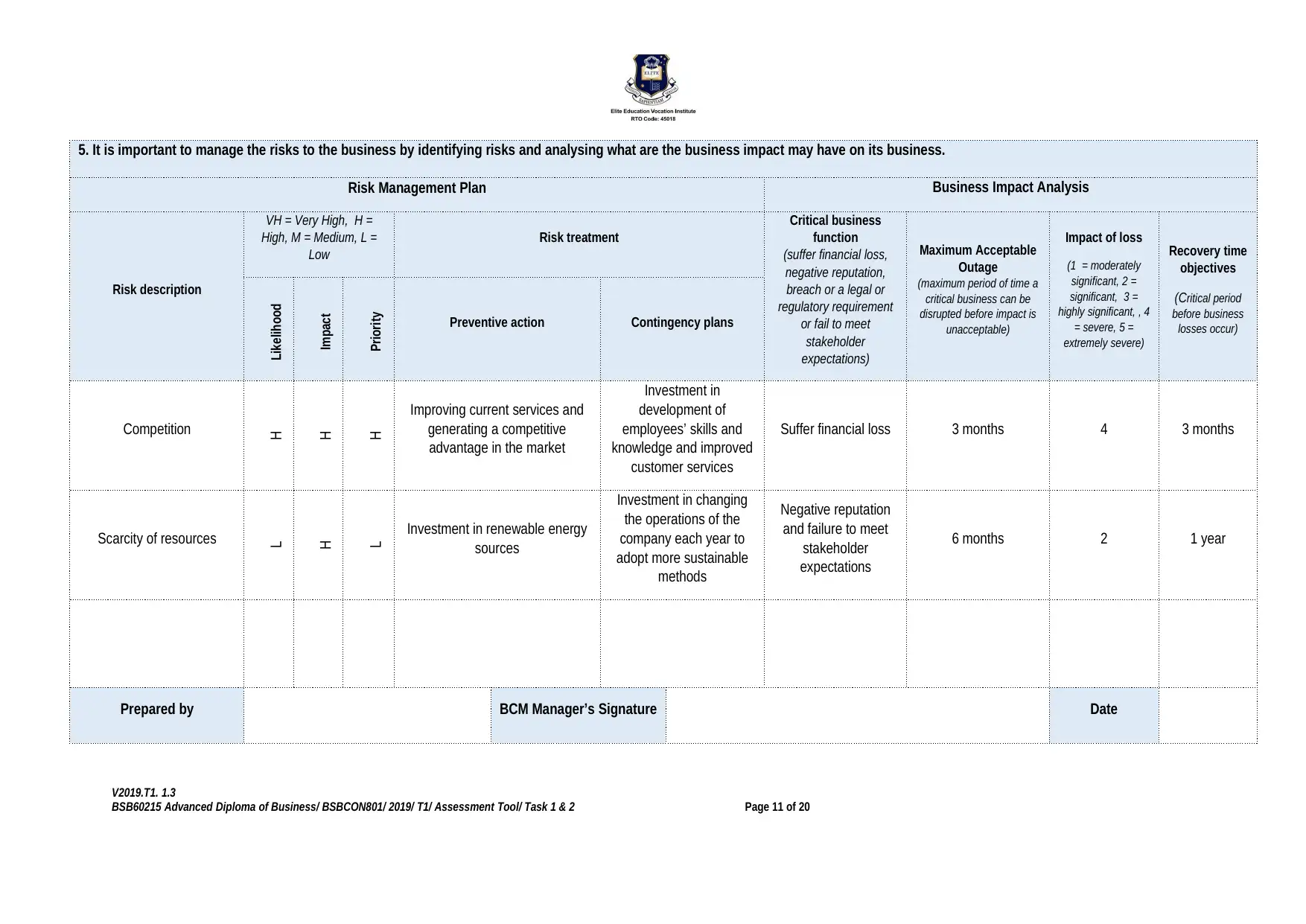
5. It is important to manage the risks to the business by identifying risks and analysing what are the business impact may have on its business.
Risk Management Plan Business Impact Analysis
Risk description
VH = Very High, H =
High, M = Medium, L =
Low
Risk treatment
Critical business
function
(suffer financial loss,
negative reputation,
breach or a legal or
regulatory requirement
or fail to meet
stakeholder
expectations)
Maximum Acceptable
Outage
(maximum period of time a
critical business can be
disrupted before impact is
unacceptable)
Impact of loss
(1 = moderately
significant, 2 =
significant, 3 =
highly significant, , 4
= severe, 5 =
extremely severe)
Recovery time
objectives
(Critical period
before business
losses occur)
Likelihood
Impact
Priority
Preventive action Contingency plans
Competition
H
H
H
Improving current services and
generating a competitive
advantage in the market
Investment in
development of
employees’ skills and
knowledge and improved
customer services
Suffer financial loss 3 months 4 3 months
Scarcity of resources
L
H
L Investment in renewable energy
sources
Investment in changing
the operations of the
company each year to
adopt more sustainable
methods
Negative reputation
and failure to meet
stakeholder
expectations
6 months 2 1 year
Prepared by BCM Manager’s Signature Date
V2019.T1. 1.3
BSB60215 Advanced Diploma of Business/ BSBCON801/ 2019/ T1/ Assessment Tool/ Task 1 & 2 Page 11 of 20
Risk Management Plan Business Impact Analysis
Risk description
VH = Very High, H =
High, M = Medium, L =
Low
Risk treatment
Critical business
function
(suffer financial loss,
negative reputation,
breach or a legal or
regulatory requirement
or fail to meet
stakeholder
expectations)
Maximum Acceptable
Outage
(maximum period of time a
critical business can be
disrupted before impact is
unacceptable)
Impact of loss
(1 = moderately
significant, 2 =
significant, 3 =
highly significant, , 4
= severe, 5 =
extremely severe)
Recovery time
objectives
(Critical period
before business
losses occur)
Likelihood
Impact
Priority
Preventive action Contingency plans
Competition
H
H
H
Improving current services and
generating a competitive
advantage in the market
Investment in
development of
employees’ skills and
knowledge and improved
customer services
Suffer financial loss 3 months 4 3 months
Scarcity of resources
L
H
L Investment in renewable energy
sources
Investment in changing
the operations of the
company each year to
adopt more sustainable
methods
Negative reputation
and failure to meet
stakeholder
expectations
6 months 2 1 year
Prepared by BCM Manager’s Signature Date
V2019.T1. 1.3
BSB60215 Advanced Diploma of Business/ BSBCON801/ 2019/ T1/ Assessment Tool/ Task 1 & 2 Page 11 of 20
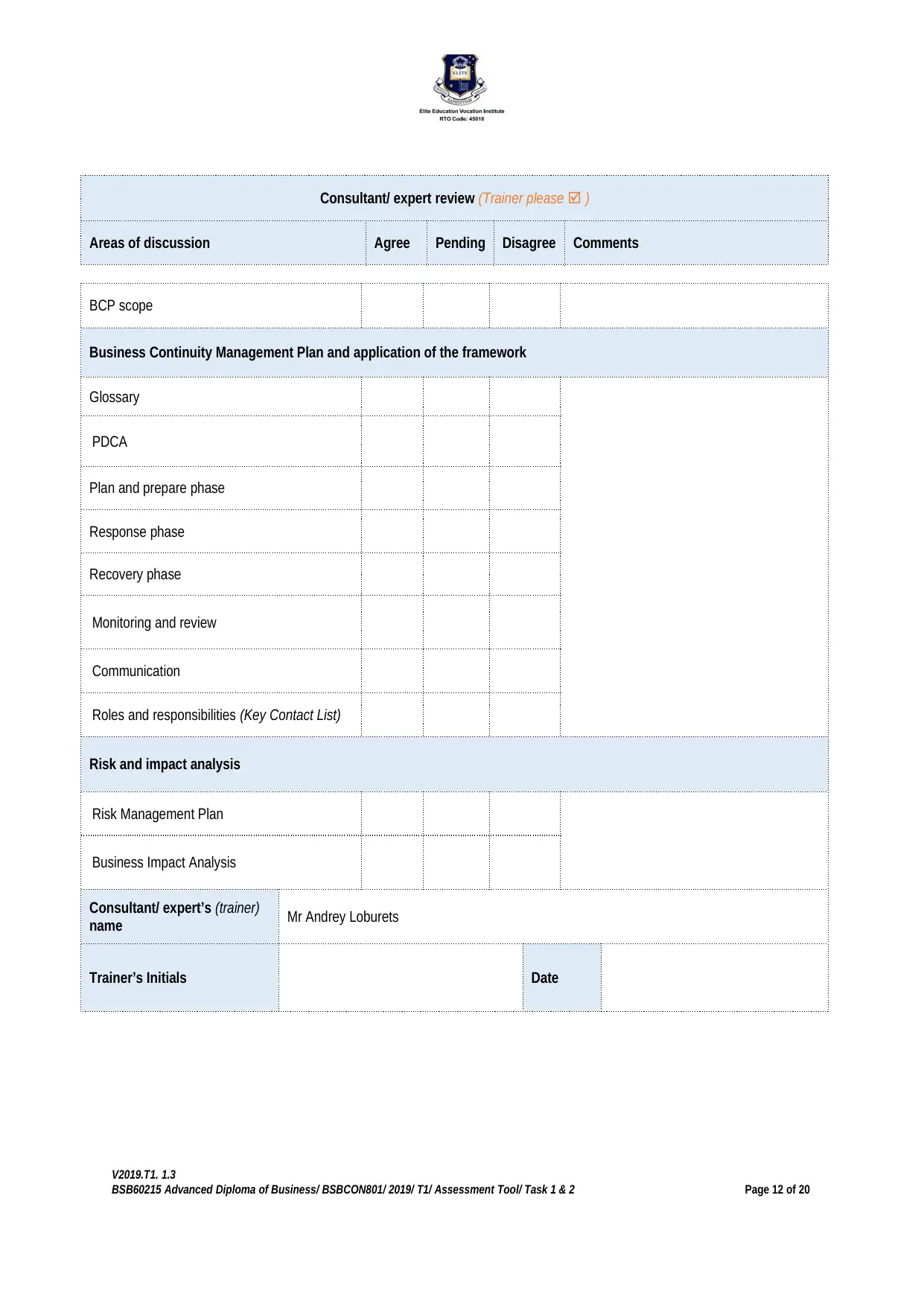
Consultant/ expert review (Trainer please )
Areas of discussion Agree Pending Disagree Comments
BCP scope
Business Continuity Management Plan and application of the framework
Glossary
PDCA
Plan and prepare phase
Response phase
Recovery phase
Monitoring and review
Communication
Roles and responsibilities (Key Contact List)
Risk and impact analysis
Risk Management Plan
Business Impact Analysis
Consultant/ expert’s (trainer)
name Mr Andrey Loburets
Trainer’s Initials Date
V2019.T1. 1.3
BSB60215 Advanced Diploma of Business/ BSBCON801/ 2019/ T1/ Assessment Tool/ Task 1 & 2 Page 12 of 20
Areas of discussion Agree Pending Disagree Comments
BCP scope
Business Continuity Management Plan and application of the framework
Glossary
PDCA
Plan and prepare phase
Response phase
Recovery phase
Monitoring and review
Communication
Roles and responsibilities (Key Contact List)
Risk and impact analysis
Risk Management Plan
Business Impact Analysis
Consultant/ expert’s (trainer)
name Mr Andrey Loburets
Trainer’s Initials Date
V2019.T1. 1.3
BSB60215 Advanced Diploma of Business/ BSBCON801/ 2019/ T1/ Assessment Tool/ Task 1 & 2 Page 12 of 20
⊘ This is a preview!⊘
Do you want full access?
Subscribe today to unlock all pages.

Trusted by 1+ million students worldwide
1 out of 20
Related Documents
Your All-in-One AI-Powered Toolkit for Academic Success.
+13062052269
info@desklib.com
Available 24*7 on WhatsApp / Email
![[object Object]](/_next/static/media/star-bottom.7253800d.svg)
Unlock your academic potential
Copyright © 2020–2025 A2Z Services. All Rights Reserved. Developed and managed by ZUCOL.




